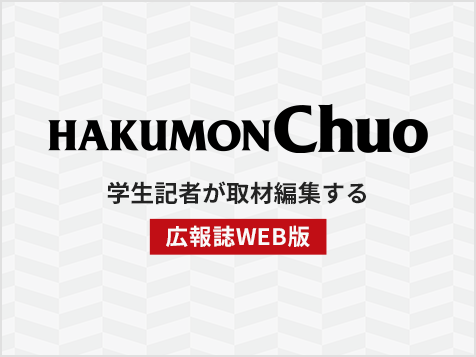中央大学について
中央大学の授業におけるデジタル技術活用の方針
本学は、「實地應用ノ素ヲ養フ」という建学の精神に基づき、デジタル技術の高度化と急速な進展など、大学を取り巻く環境の変化にも適切に対応しつつ、学修者本位の教育の実現とその質を保証すべく、高度で先進的な教育を推進する。
もとより、大学における「学び」においては、単に知識・技能の修得に留まらず、教員と学生との間や学生間で相互に交わされる議論を通じて、知識や考え方の深化が行われることが極めて重要である。そのため、本学で実施する授業については、各教育研究組織の定める「3つの方針」に基づく教育の実質化を行うべく、面接授業を基本としつつ、時代に即したデジタル技術を積極的に活用し、計画性の高い授業設計のもとで、以下に例示する授業を多様に組み合わせて展開することにより、更なる教育の質的向上とその質の保証に努めることを基本方針とする。
一方で、本学におけるあらゆる教育・経験がデジタル技術を活用した学修環境によって代替されるものではないということにも留意しなければならない。本方針は、本学において実施する授業を面接授業と遠隔授業に機械的に二分し、後者のみを推進すること、また、面接授業の安易な代替物として遠隔授業を位置付けるのではなく、双方の教育手法の長所や利点を最大限に生かし、これらを相乗することにより、時代に即した教育の在り方と新たな可能性を追求するために設定するものである。
<デジタル技術の積極的な活用が期待される授業例>
●デジタル技術を活用することにより、学生の能動的・主体的な学修参加の拡大を志向する授業
(期待される効果)
- 授業時間内外でコミュニケーションツールを用いることで、特に授業内においては学生からの教員への質問や意見に対する壁を無くし、また、授業外においては学生同士または学生・教員間でこれらのツールを用いることで「学びあい(ピア・ラーニング)の環境」を醸成するなど、多方向型のコミュニケーションを加速させ、学生の主体的学修を促す。
- チャットツールやオンライン掲示板などを活用し、質疑・応答を通じた能動的な学修姿勢を醸成することで、学生の知識・技能を深化させる。
- 教員による授業解説を、デジタル技術を活用した予習(事前学習)と位置づけ、面接授業ではグループワークなど発展的学習に取り組ませることにより、学生の知識・技能を深化させる(反転授業)。
●デジタル技術を活用することにより、学生を時間的制約から解放し、教育の質的向上を志向する授業
(期待される効果)
- 学生が自分のペースで学習できるメリットを生かし、学生の集中力を維持しながら、学生・教員間での多方向性を確保したフォローアップを丁寧に行うこと、また、授業時間外における予復習に十全な時間を確保することで、知識・技能の確実な定着を図る。
- デジタル技術を活用した映像・資料配信と、学生個々の理解度に応じた授業内外における適切なフォローアップを組み合わせ、学び方に対する学生の意識を高めることで、適切な学習量を提供し、授業内容に対する理解を深化させる。
●デジタル技術を活用することで、学生の地理的・空間的制約を解消することにより、教育におけるダイバーシティ拡大を志向する授業
(期待される効果)
- 所属する教育研究組織やキャンパスの枠を超えて、多様なリテラシー教育や専門教育、学際的教育を受けることを可能とする。
- 遠隔地から講師をゲストとして招聘するなど、幅広い人的ネットワークを活用することで社会との接点の創出や実務経験の継承、学問への理解を促す。
- 学生のおかれた状況に応じてデジタル技術を活用することで、学生一人ひとりの環境に対応した学修機会を確保する。
- 国内外の他大学等とオンラインツールを活用した教育を展開することにより、授業参加者のダイバーシティを拡大し、学内のリソースを超えた人・知・経験の交流を促進する。
●デジタル技術を活用することで、高等学校や企業等に対しても授業を開放し、高大連携教育の推進や社会連携・社会貢献などの新たな価値創造を志向する授業
以上
Policy on the Use of Digital Technology in Chuo University Classes
Under the founding spirit of “Fostering the Ability to Apply Knowledge to Practice,” Chuo University will promote innovative education to realize learner-centered education and guarantee its quality, while responding appropriately to changes around the University, such as the advancement and rapid development of digital technology.
For “learning” at a university, not only the acquisition of knowledge and skills, but also the deepening of knowledge and thinking through discussions between faculty members and students and among students are extremely important. For this reason, and to promote education based on the “Three Policies” (admissions, curriculum, and diploma) set by each Chuo educational and research institution, the basic strategy will be to enhance and guarantee the quality of education by: (1) actively utilizing digital technology in keeping with the times based on face-to-face classes; and (2) diversely combining the classes exemplified below, under well-planned class design.
At the same time, it should be noted that not all education and experiences at the University will be appropriate for a learning environment utilizing digital technology. This Policy is not intended to mechanically divide classes conducted at the University into face-to-face classes and distance learning, and to promote only the latter, nor is it to position distance learning as an easy alternative for face-to-face classes, but to maximize the advantages and the benefits of both educational methods, and to pursue approaches to education fitting the times and new possibilities through appropriate synergies.
< Example of Classes in which the Active Use of Digital Technology is Expected >
1.Classes that aim for an expansion of students’ active and self-motivated learning participation through the utilization of digital technology
(Expected effects)
- Accelerate multi-directional communication and prompt students’ self-directed learning by using communication tools both inside and outside the classes. These tools will help remove barriers in classes that prevent students from asking questions and stating opinions to faculty members, and will foster a “peer learning environment” among students and between students and faculty members.
- Deepen students’ knowledge and skills by using chat tools and online bulletin boards. These tools will foster students’ self-motivated learning through the exchange of questions and answers.
- Deepen the students’ knowledge and skills through faculty member lectures provided as preparatory study using digital technology, and having students engage in progressive learning, such as group work in face-to-face classes (flipped classroom).
2.Classes that aim for greater educational quality by freeing students from time constraints through the utilization of digital technology
(Expected effects)
- Secure the acquisition of knowledge and skills by conducting careful follow-up in multiple directions between students and faculty members, while maintaining students’ concentration, and by securing sufficient time for preparation and review outside of classes, using digital technology to allow students to study at their own pace.
- Deepen the students’ understanding of class contents by raising students’ awareness of how to learn through: (1) a combination of video/document delivery using digital technology and suitable follow-up inside and outside of classes based on each student’s level of understanding; and (2) provision of appropriate workloads.
3.Classes that aim to expand diversity in education through the elimination of students’ geographical restrictions through the utilization of digital technology
(Expected effects)
- Enable students to receive diverse literacy education, specialized education, and interdisciplinary education beyond the boundaries of their educational and research institutions and campuses.
- Utilize a broad human network, including guest lecturers from distant areas, to create contacts with society, pass on practical experience, and promote understanding of academics.
- Secure learning opportunities that match each student’s environment through the utilization of digital technology based on the student’s situation.
- Promote the exchange of people, knowledge, and experience beyond the resources of the University to expand the diversity of class participants, using online tools in cooperation with other universities both inside and outside Japan.
4.Classes that aim for the creation of new value, including promotion of education through cooperation with high schools and cooperation with and contributions to society, by opening classes to high schools and to companies through the utilization of digital technology.

